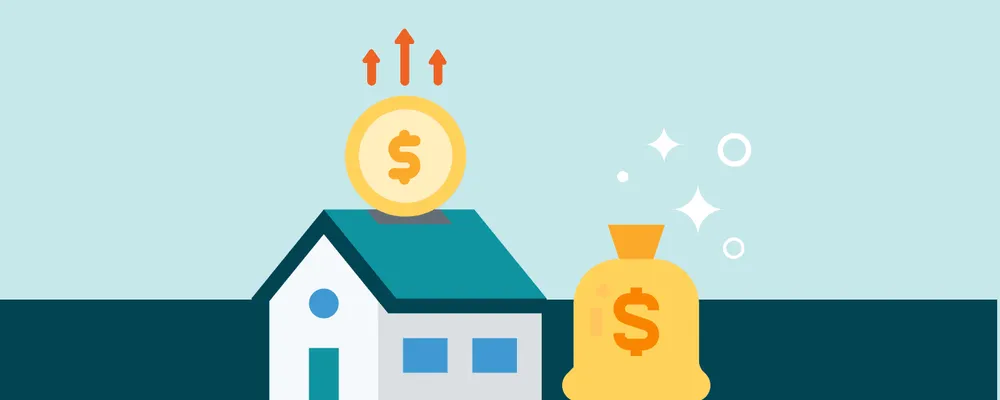There are a lot of expenses when it comes to buying a home. From the down payment to closing costs, don’t forget fees for your inspections, appraisal, and other services. You might also have to pay for mortgage insurance depending on your loan.
If you’re planning to apply for a mortgage soon, make sure you understand what your insurance requirements may be — and how much they’ll cost you.
What is mortgage insurance?
Mortgage insurance shouldn’t be confused with homeowners insurance. Homeowners insurance is meant to protect you from financial loss if there’s an issue or damage to your property. Mortgage insurance, on the other hand, is designed to protect your lender if you can’t repay your loan.
Here’s the difference in how each type of insurance works:
- Homeowners insurance: You’ll purchase this insurance to cover damage and liability on your property. If your home is burglarized, damaged in a storm, or experiences some other issue, your insurance will help cover the costs.
- Mortgage insurance: When you get a mortgage loan, your lender might require you to pay for a mortgage insurance policy. In the event you fall behind on your mortgage, the lender calls on that policy to recoup their losses.
Good to know: Mortgage insurance doesn’t offer protection for you, the borrower, though it will allow you to make a lower down payment when buying your home.
Learn More: How to Buy a House
How does mortgage insurance work?
Depending on the lender and type of loan, you’ll have to pay for your mortgage insurance costs upfront or on a monthly basis as part of your mortgage payment. FHA loans require both an upfront premium and an annual premium.
While mortgage insurance can make it easier to qualify for a home loan, your monthly payment will be higher. And, since mortgage insurance is designed to protect the lender, not you, you’re still at risk of losing your home if you fall behind on payments.
When do you need mortgage insurance?
When you get a mortgage, insurance varies by loan product. Here’s what you can expect with each type of loan:
- Conventional loans: On conventional loans, you’ll only need mortgage insurance if you make a down payment under 20% (sometimes, not even then). Conventional loans don’t require an upfront mortgage insurance payment — just a monthly one you’ll pay along with your mortgage.
- FHA loans: If you’re getting an FHA loan, mortgage insurance will always be required both upfront and annually (spread across your monthly mortgage payments).
- USDA loans: USDA loans also require upfront and annual premiums, though they’re referred to as “guarantee fees.”
VA loans do not require mortgage insurance. There is a “funding fee,” but this is paid at closing and can be rolled into the loan balance.
Get your personalized mortgage quote today with Credible
Find Rates NowChecking rates won't affect your credit score
How much is mortgage insurance?
Several factors determine your mortgage insurance cost:
- Loan type: The premiums are different for conventional mortgages and FHA loans as conventional lenders consider your credit history. An FHA loan charges a fixed percentage using your loan amount and payment term.
- Loan amount: Premiums are higher for more expensive loans as lenders charge a percentage of the loan value.
- Down payment: A larger down payment can reduce your total insurance premiums as your loan-to-value ratio (LTV) is lower. Use our LTV calculator to learn more.
- Credit score: Private mortgage insurance rates can be lower if you have a credit score of at least 700. A higher credit score can also help you qualify for the best mortgage rates. FHA loans do not use your credit history for mortgage insurance.
Private mortgage insurance on a conventional loan typically costs between 0.2% and 2% of the loan amount annually.
All FHA loans require an upfront mortgage insurance premium (UFMIP) of 1.75%. Your annual mortgage insurance premium (MIP) depends on your loan-to-value ratio and loan term:
- Loan term longer than 15 years: 0.80% (LTV up to 95%) to 0.85% (LTV above 95%)
- Loan term of 15 years or less: 0.45% (LTV up to 90%) to 0.70% (LTV above 90%)
How to calculate mortgage insurance
First, compare the home value to your loan amount and down payment to get your loan-to-value ratio. Asking your lender for rates within your credit score range can increase the accuracy of your projection.
For conventional mortgages with private mortgage insurance (PMI), you can use the 0.20% and 2% range to estimate the low end and high end of your annual cost. For FHA mortgages, your upfront premium is 1.75% in addition to your annual premium.
To get your monthly premium, simply divide these calculations by 12.
Your lender will disclose your mortgage insurance premium in your loan estimate and closing disclosure.
What’s the difference between PMI and MIP?
There are two types of mortgage insurance: PMI (private mortgage insurance) and MIP (mortgage insurance premiums). Here’s how those differ:
- PMI: PMI is what you’ll need on a conventional mortgage, and your lender will choose the policy.
- MIP: MIP is the insurance required on FHA loans.
With USDA loans, the Department of Agriculture is the guarantor, so your premiums will be paid directly to the USDA as part of your mortgage payment.
Credible makes getting a mortgage easy
Let's get startedChecking rates won't affect your credit score
Types of mortgage insurance
The type of mortgage you apply for determines which mortgage insurance program you can use.
1. Borrower-paid monthly mortgage insurance (BPMI)
Borrower-paid monthly mortgage insurance (BPMI) is the most common type of private mortgage insurance. With this insurance, you’ll make monthly payments until you reach 22% equity (78% loan-to-value ratio), after which the lender will automatically cancel the PMI.
You can also request to cancel your remaining mortgage insurance payments once you achieve a 20% equity position in relation to the original purchase price or current appraisal value.
2. Lender-paid mortgage insurance (LPMI)
With lender-paid mortgage insurance (LPMI), your lender may offer to “pay” your mortgage insurance premiums. To cover this cost, lenders will typically charge a higher rate or charge an additional fee.
It’s possible to have a lower monthly payment with this option, but you’ll pay a higher rate and, in turn, more interest over the life of the loan. You also will not be able to reduce your interest rate or cancel LPMI once you surpass 22% equity unless you refinance.
Keep Reading: How to Pay Off Your Mortgage Faster
3. Single-premium mortgage insurance
A single-premium mortgage insurance payment lets you pay the entire mortgage insurance cost upfront to reduce your monthly payment.
While your upfront closing costs are higher, this allows you to pay less over the long term for mortgage insurance.
Tip: Monthly borrower-paid payments can be more cost-effective if you plan on selling your house or refinancing within a few years as your single-premium may not be non-refundable.
4. Split-premium mortgage insurance
You can pay some of your mortgage insurance upfront and some of it monthly. As a result, your monthly payment will be lower than if you opted for BPMI, and you’ll pay less at closing than you would with single-premium mortgage insurance.
This option is relatively uncommon but can help you qualify for a mortgage with a high debt-to-income ratio.
5. FHA mortgage insurance premium (MIP)
All FHA home loans require a type of mortgage insurance called a mortgage insurance premium, in which you’ll make an upfront payment and annual payments.
If your down payment is less than 10%, you’ll pay annual premiums for the entire mortgage term. But, if your down payment is more than 10%, you’ll only pay annual premiums for the first 11 years.
Tip: It’s possible to eliminate your MIP payments by refinancing your FHA loan into a conventional loan. If you have 20% equity in your home, you should be able to refinance into a conventional loan with no PMI.
What should you know about mortgage insurance?
Mortgage insurance can be complicated to understand, especially if you’re a first-time homebuyer.
So if you’re feeling confused about mortgage insurance, just remember these basics:
- Mortgage insurance protects the mortgage lender — not you. Though you’re footing the bill, mortgage insurance won’t protect you if you fall behind on your mortgage — only your lender. The lender can still foreclose on your home, but they are able to recoup the losses through the insurance policy.
- Your mortgage insurance requirements depend on your home loan. Not all loans require mortgage insurance, and mortgage rates vary greatly from one loan product to the next.
- Sometimes you can roll the fee into your loan balance. You can’t do this with conventional PMI, but on FHA loans, you can actually finance your upfront mortgage premiums and roll them into your loan. You can also do this with the guarantee fees and funding fees on USDA and VA loans. Keep in mind this will increase your loan balance, monthly payments, and total interest paid over time.
- You might be able to cancel your mortgage insurance later on. With PMI, you can cancel your mortgage insurance once you reach an 80% loan-to-value ratio (you’ve paid off at least 20% of the home’s value). On FHA loans, you can cancel after 11 years if you made at least a 10% down payment.
- Mortgage insurance premiums vary. You’ll pay 1.75% upfront for an FHA loan, and then anywhere from 0.45% to 1.05% annually. Conventional mortgage insurance rates vary depending on your down payment amount and credit score, and USDA rates are 1% upfront and 0.35% every year.
How can you avoid mortgage insurance?
Mortgage insurance isn’t always a requirement. Here are several ways to keep your monthly payment as low as possible:
- Make a qualifying down payment: Having a down payment of at least 20% of the home value waives the private mortgage insurance requirement.
- Reduce your loan-to-value ratio: Even if a conventional lender requires PMI, you can request cancellation once your LTV is 80% or less. Private lenders automatically cancel PMI when your LTV reaches 78%.
- Avoid government-backed loans: FHA, VA, and USDA loans charge mortgage insurance or an equivalent fee. You may have to pay this premium for the entire repayment term.
- Apply for a piggyback mortgage: A piggyback mortgage is a second mortgage that you can take out in addition to your primary mortgage. Doing so helps you avoid PMI on your first mortgage. For instance, if you can only afford a 10% down payment, you can take out a primary mortgage for 80% of the home value, and then use a piggyback mortgage to cover the remaining 10%.
Avoiding mortgage insurance is just one way to lower your costs as a homebuyer. If you want to save even more on your home purchase, make sure you shop around for mortgage rates first.







